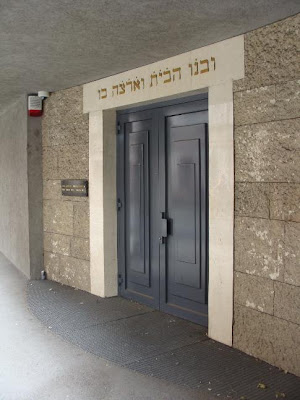Resuming my intended series of Austrian memory posts (previous entries
here and
here) after a long hiatus, I would like to say something about the Jews of Innsbruck. Though Innsbruck's first Jewish residents arrived in the 13th century, the city was never a major center of Jewish life; the local Jewish community apparently peaked in size just before the First World War, when Innsbruck had approximately five hundred Jewish residents out of a total population of roughly sixty-six thousand. In the wake of the Holocaust, the Jewish presence in Innsbruck nearly vanished: over two hundred Jews from Tyrol and Vorarlberg died at the hands of the Nazis, and survivors who had lived in Innsbruck before the Second World War were slow to return. The reconstituted Jewish presence in Tyrol is very small - the local synagogue estimates the size of the community at around one hundred - but the Jews of Innsbruck remain proud witnesses of a tradition with deep local roots.
The photos featured above depict the most enduring reminder of Innsbruck's longstanding Jewish presence, the remains of an old Jewish cemetery nestled in the wooded foothills north of the city at a spot known as the Judenbühel (literally "Jews' Hill"). The Judenbühel was the final resting place for Innsbruck's Jews from the late 1500s until the 1860s, when the community moved its burial site to the Westfriedhof, a large cemetery located within the city itself. For nearly a century and a half, the site of the old Jewish cemetery remained abandoned and largely neglected. Finally, in July 2009, the memorial visible in the above photos was dedicated by the Chief Rabbi of Austria, Paul Chaim Eisenberg.
Though the Judenbühel is no longer a burial site - the bodies once interred here were long ago moved to the Westfriedhof - the enclosure of the boundaries of the old cemetery with the tombstone-like metal panels seen above creates a palpable sense of sacred space. The Judenbühel's isolation was once a liability, making the cemetery inaccessible during winter and more vulnerable to attack by anti-Semitic vandals. Now, however, this peaceful site is an ideal spot for quiet reflection - a place where one may be led first to wonder about the lives of the people who were once buried here, and then to consider how one might honor their memory today.





The Jewish section of Westfriedhof, glimpsed in this second group of photos, offers a poignant reminder of the prosperous, culturally assimilated Jewish community that made its home in Innsbruck in the late 19th and early 20th centuries. Many older headstones note the occupations of the deceased, with some also featuring narratives attesting to their accomplishments. Also noteworthy is a memorial (visible in the second photo of this group) honoring local Jews who fought and died in the armed forces of the Austro-Hungarian Empire during the First World War; the
Chewra Kadischa mentioned on the memorial's inscription is a traditional Jewish burial society.
Though the Jewish section of the Westfriedhof includes an explicit memorial to the victims of the Holocaust (visible in the last photo of the group), many individual family grave markers include the names of family members who perished at the hands of the Nazis (the fourth photo in this group offers an example), listed with others who died in more peaceful times. In contrast with the long-neglected Judenbühel, the Jewish section of the Westfriedhof is well cared-for and appears likely to continue serving the community into the foreseeable future.
The final stop on this tour is Innsbruck's only synagogue, located across the street from the Jesuit residence where I lived last summer. The
Israelitische Kultusgemeinde für Tirol und Vorarlberg is the only active synagogue in either of the two westernmost federal states in Austria; serving a small, scattered Jewish community, the synagogue in Innsbruck has no resident rabbi and offers scheduled services only on the high holy days of Rosh Hashanah and Yom Kippur. On the first night of Passover, Jews from across Tyrol and Vorarlberg also gather here to break bread and celebrate together as a community.
Even though worship services are only offered here several times a year, the synagogue's mere presence makes a statement about the resilience of the local Jewish community. Dedicated in 1993, the structure was built on the site of an earlier synagogue destroyed by aerial bombing during World War II. The Hebrew inscription above the door - "Build me this house and I shall live in it" - speaks not only about the Almighty but about the aspirations of a community that decided to return to Innsbruck and make a new home for itself after being driven away and nearly destroyed. This time, the inscription seems to suggest, the Jews of Innsbruck are here to stay. AMDG.





















